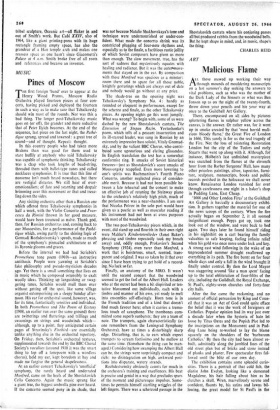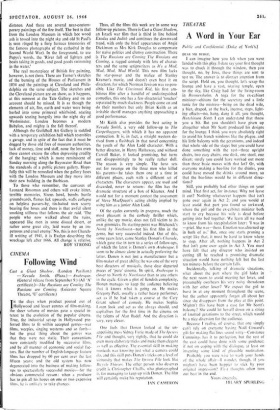Malicious Flame
ART AL those mewed up working their way through mounds of mouldering manuscripts on a hot summer's day seeking the answers to vital problems, such as who was the mother of the Dark Lady of the Sonnets or what was Ben Jonson up to on the night of the twenty-fourth, throw down your pencils and hie your way at once to the Guildhall Art Gallery.
There, encompassed on all sides by pictures spluttering flames in sulphur yellow across the canvas, is the answer. Or rather was, for it went up in smoke created by that 'most horrid mali- cious bloody flame,' the Great Fire of London in 1666. This surely is for us the real tragedy of the Fire. Not the loss of roistering Restoration. London but the city of the Tudors and early Stuarts that went up along with it. Although, for instance, Holbein's last unfinished masterpiece was snatched from the flames at the eleventh hour from the Barber Surgeons' Hall, how many other priceless paintings, silver, tapestries, furni- ture, sculpture, manuscripts, books and public records perished in the holocaust we shall never. know. Renaissance London vanished for ever through carelessness one night in a baker's shop in Pudding Lane, East Cheap.
'1666 and Other London Fires' at the Guildhall Art Gallery is basically a documentary exhibi- tion. It gathers together the material for one of the news scoops of the century. When the fire actually began on September 2, it all seemed insignificant enough. Pepys got up, took one look out of the window, and went back to bed again. Two days later he found himself riding in his nightshirt on a cart bearing the family valuables to safe keeping, feeling infinite relief when his gold was once more under lock and key. A strong east wind following in the wake of an unprecedented summer drought swallowed up everything in its path. The fire burnt on for four whole days and only a fall in the wind brought it finally under control. By then the Lord Mayor was staggering around 'like a man spent' facing up to the total obliteration of four-fifths of the city, including the Guildhall, the Royal Exchange, St Paul's, eighty-seven churches and forty-four city halls.
After the fire came the reckoning, and no amount of official persuasion by King and Coun- cil that it was an Act of God could quite efface the belief that it was the work of foreigners or Catholics. Popular opinion had its way just over a decade later when the hysteria of hate let loose by Titus Oates and the Popish Plot led to the inscriptions on the Monument and in Pud- ding Lane being re-worked to lay the blame squarely on the shoulders of the 'barbarous Catholics.' By then the city had been almost re- built, admittedly along the jumbled lines of the old street plan but of bricks and stone instead of planks and plaster. Few spectacular fires fol- lowed until the blitz of our own day.
The exhibition contains some splendid curio- sities. There is a portrait of that cold fish, the diarist John Evelyn, looking like a demented Magdalene, his hair falling about him as he clutches a skull. Wren, marvellously serene and confident, flaunts by, his satins and lawns bil- lowing, the great model for St Paul's in the distance. And there are several near-contem- porary paintings of the fire itself. The best is that from the London Museum in which hot wood ash is tossed into the night sky and old St Paul's is seen ringed by a fiery furnace (memories of the famous photographs of the cathedral in the Second World War). In the foreground, to use Pepys's words, the 'River full of lighters and boats taking in goods, and good goods swimming in the water.'
The real masterpiece of British fire painting, however, is not there. These are Turner's sketches of the burning of the Houses of Parliament in 1834 and the paintings at Cleveland and Phila- delphia on the same subject. The sketches and the Cleveland picture are on show, as it happens, at this moment at the Tate Gallery and on no account should be missed. It is as though the elements of air, fire, earth and water were being hurled into some primeval whirlwind, soaring upwards tearing hungrily into the night sky of Westminster. London becomes a modern Babylon, and mighty is the fall thereof.
Although the Guildhall Art Gallery is saddled with a temporary exhibition hall which resembles a garage, and in spite of the fact that it must be dogged by those old foes of museum authorities, lack of money, time and staff, none the less even these cannot excuse the often depressing crudity of the hanging; which is more reminiscent of Sunday morning along the Bayswater Road than the standards of a public picture gallery. Hope- fully this will be remedied when the gallery fuses with the London Museum and they move into their new building in the Barbican.
To those who remember, the canvases of Leonard Rosoman and others will evoke bitter, terrible memories. Sirens - howl, bombs hurtle groundwards, flames lick upwards, walls collapse on helpless passers-by, tin-hatted men scurry bearing fire hoses and there is that awful silent smoking stillness that follows the air raid. `The people who now walked about the ruins, appeared like men in some dismal desert, or rather some great city, laid waste by an im- petuous and cruel enemy.' No, this is not Church- ill writing of 1941, it is Evelyn describing the wreckage left after 1666. All change is relative.
ROY STRONG































 Previous page
Previous page